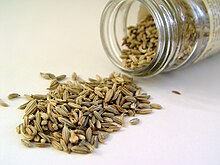(Foeniculum vulgare)
-The word fennel developed from the Middle English fenel or fenyl.
-This came from the Old English fenol or finol, which in turn came from the Latin feniculum or foeniculum, the diminutive of fenum or faenum, meaning "hay".
-The Latin word for the plant was ferula, which is now used as the genus name of a related plant. As Old English finule it is one of the nine plants invoked in the pagan Anglo-Saxon Nine Herbs Charm, recorded in the 10th century.
-In Ancient Greek, fennel was called marathon (μάραθον), and is attested in Linear B tablets as ma-ra-tu-wo. John Chadwick noted this word is the origin of the place name Marathon(meaning "place of fennel"), site of the Battle of Marathon in 490 BC; however, Chadwick wryly noted he has "not seen any fennel growing there now". In Greek mythology, Prometheus used the stalk of a fennel plant to steal fire from the gods. Also, it was from the giant fennel, Ferula communis, that the Bacchanalian wands of the god Dionysus and his followers were said to have come.
In Italy, the word for fennel (finocchio) is used in a derogatory way to refer to a homosexual. This use is traced back to the time of the Italian Inquisition, and remains in use today.
Fennel is used as a food plant by the larvae of some Lepidoptera species including the mouse moth and the anise swallowtaill.
 |
| Fennel flowerheads |
 |
| Fennel flowerheads |
 |
| Florence fennel bulbs |
 |
| Florence fennel bulbs |
 |
| Saunf or fennel seeds used as a spice and anafter-mint in India and Pakistan |
 |
| Fennel seeds |
Properties: antispasmodic, aromatic, carminative, diuretic, expectorant, galactagogue, stimulant.
What it affects: stomach, nerves, intestines and eyes.
Preparation and amounts:
Infusion: steep for 5-15 min. and take 6 oz. 3x a day.
Fluid extract: drink 5-60 drops 3x a day
Oil: take 1-5 drops 3x a day
Powder: drink the average dose of 3 #0 capsules (15 grains)
Purposes:
Internally, although the seeds are mainly used, both the seeds and roots of fennel are excellent stomach and intestinal remedies. It promotes the function of the kidney, spleen and liver, and helps clear the lungs. It helps to arouse the appetite, and relieve colic and abdominal cramps. It relieves abdominal and colon disorders. It expels mucous accumulations. it is especially used to reduce gastro- intestinal tract spasms and expel flatulence. For this purpose, take fennel oil with honey or as a saturated solution in water. Add it also to gargle for coughing and hoarseness. It is used to treat acid stomach, colic and cramps. In larger doses, it removes obstructions of the liver, spleen and gallbladder. Fennel will increase the flow of urine, menstrual blood and mother's milk.
Externally, fennel can be used as an eyewash.
Fennel is an excellent source of vitamin C. It is also a very good of dietary fiber, potassium, manganese, folate, and molybdenum. In addition, fennel is a good source of niacin as well as the minerals phosphorus, calcium, magnesium, iron, and copper.
Plant Description:It is erect, glaucous green, and grows to heights of up to 2.5 m, with hollow stems. The beautiful leaves grow up to 40 cm long; they are finely dissected, with the ultimate segments filiform (threadlike), about 0.5 mm wide. (Its leaves are similar to those of dill, but thinner.) The fine flower are produced in terminal compound umbels 5–15 cm wide, each umbel section having 20–50 tiny yellow flowers on short pedicels. The fruits is a dry seed from 4–10 mm long, half as wide or less, and grooved.
No comments:
Post a Comment